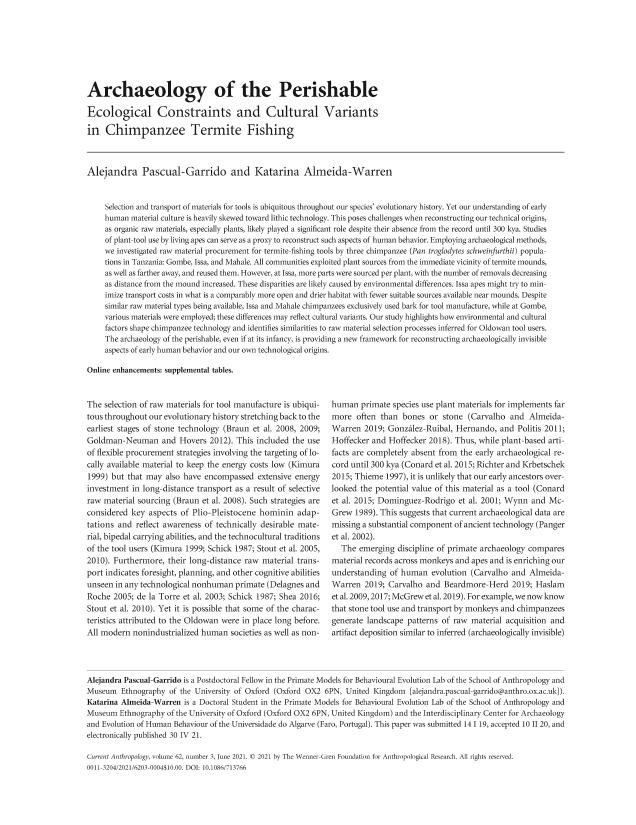Mostrar el registro sencillo del ítem
dc.contributor.author
d'Errico, F.
dc.contributor.author
Backwell, Lucinda Ruth

dc.date.available
2021-10-12T12:46:04Z
dc.date.issued
2021-06
dc.identifier.citation
d'Errico, F.; Backwell, Lucinda Ruth; Archaeology of the perishable ecological constraints and cultural variants in chimpanzee termite fishing; University of Chicago Press; Current Anthropology; 62; 3; 6-2021; 333-362
dc.identifier.issn
0011-3204
dc.identifier.uri
http://hdl.handle.net/11336/143259
dc.description.abstract
Selection and transport of materials for tools is ubiquitous throughout our species’ evolutionary history. Yet our understanding of early human material culture is heavily skewed toward lithic technology. This poses challenges when reconstructing our technical origins, as organic raw materials, especially plants, likely played a significant role despite their absence from the record until 300 kya. Studies of plant-tool use by living apes can serve as a proxy to reconstruct such aspects of human behavior. Employing archaeological methods, we investigated raw material procurement for termite-fishing tools by three chimpanzee (Pan troglodytes schweinfurthii ) populations in Tanzania: Gombe, Issa, and Mahale. All communities exploited plant sources from the immediate vicinity of termite mounds, as well as farther away, and reused them. However, at Issa, more parts were sourced per plant, with the number of removals decreasing as distance from the mound increased. These disparities are likely caused by environmental differences. Issa apes might try to minimize transport costs in what is a comparably more open and drier habitat with fewer suitable sources available near mounds. Despite similar raw material types being available, Issa and Mahale chimpanzees exclusively used bark for tool manufacture, while at Gombe, various materials were employed; these differences may reflect cultural variants. Our study highlights how environmental and cultural factors shape chimpanzee technology and identifies similarities to raw material selection processes inferred for Oldowan tool users. The archaeology of the perishable, even if at its infancy, is providing a new framework for reconstructing archaeologically invisible aspects of early human behavior and our own technological origins.
dc.format
application/pdf
dc.language.iso
eng
dc.publisher
University of Chicago Press
dc.rights
info:eu-repo/semantics/openAccess
dc.rights.uri
https://creativecommons.org/licenses/by-nc-sa/2.5/ar/
dc.subject
CHIMPANZEE
dc.subject
TOOL USE
dc.subject
EARLY HOMININ
dc.subject.classification
Zoología, Ornitología, Entomología, Etología

dc.subject.classification
Ciencias Biológicas

dc.subject.classification
CIENCIAS NATURALES Y EXACTAS

dc.title
Archaeology of the perishable ecological constraints and cultural variants in chimpanzee termite fishing
dc.type
info:eu-repo/semantics/article
dc.type
info:ar-repo/semantics/artículo
dc.type
info:eu-repo/semantics/publishedVersion
dc.date.updated
2021-07-26T15:13:08Z
dc.journal.volume
62
dc.journal.number
3
dc.journal.pagination
333-362
dc.journal.pais
Estados Unidos

dc.description.fil
Fil: d'Errico, F.. Universite de Bordeaux; Francia
dc.description.fil
Fil: Backwell, Lucinda Ruth. Consejo Nacional de Investigaciones Científicas y Técnicas. Centro Científico Tecnológico Conicet - Tucumán. Instituto Superior de Estudios Sociales. Universidad Nacional de Tucumán. Instituto Superior de Estudios Sociales; Argentina
dc.journal.title
Current Anthropology

dc.relation.alternativeid
info:eu-repo/semantics/altIdentifier/doi/http://dx.doi.org/10.1086/713766
dc.relation.alternativeid
info:eu-repo/semantics/altIdentifier/url/https://www.journals.uchicago.edu/doi/10.1086/713766
Archivos asociados
